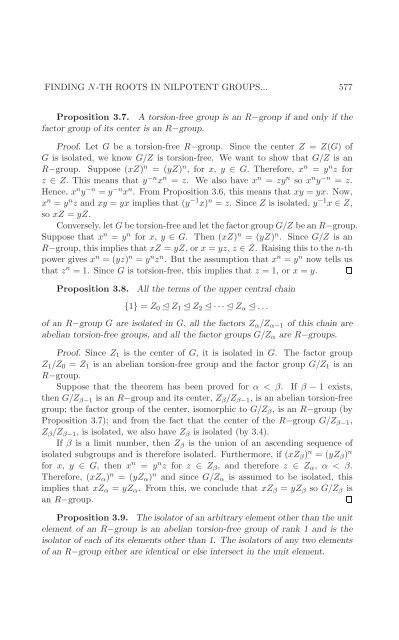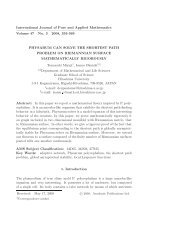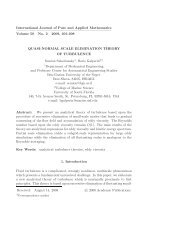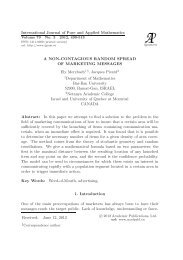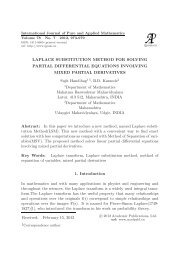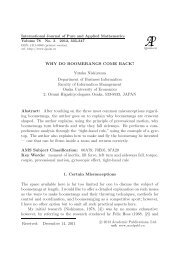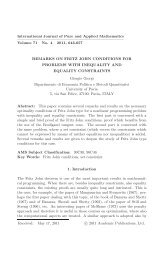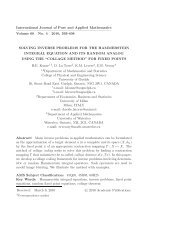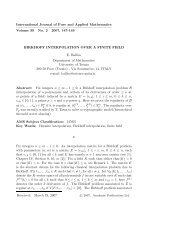FINDING N-TH ROOTS IN NILPOTENT GROUPS AND ...
FINDING N-TH ROOTS IN NILPOTENT GROUPS AND ...
FINDING N-TH ROOTS IN NILPOTENT GROUPS AND ...
You also want an ePaper? Increase the reach of your titles
YUMPU automatically turns print PDFs into web optimized ePapers that Google loves.
<strong>F<strong>IN</strong>D<strong>IN</strong>G</strong> N-<strong>TH</strong> <strong>ROOTS</strong> <strong>IN</strong> <strong>NILPOTENT</strong> <strong>GROUPS</strong>... 577<br />
Proposition 3.7. A torsion-free group is an R−group if and only if the<br />
factor group of its center is an R−group.<br />
Proof. Let G be a torsion-free R−group. Since the center Z = Z(G) of<br />
G is isolated, we know G/Z is torsion-free. We want to show that G/Z is an<br />
R−group. Suppose (xZ) n = (yZ) n , for x, y ∈ G. Therefore, x n = y n z for<br />
z ∈ Z. This means that y −n x n = z. We also have x n = zy n so x n y −n = z.<br />
Hence, x n y −n = y −n x n . From Proposition 3.6, this means that xy = yx. Now,<br />
x n = y n z and xy = yx implies that (y −1 x) n = z. Since Z is isolated, y −1 x ∈ Z,<br />
so xZ = yZ.<br />
Conversely, let G be torsion-free and let the factor group G/Z be an R−group.<br />
Suppose that x n = y n for x, y ∈ G. Then (xZ) n = (yZ) n . Since G/Z is an<br />
R−group, this implies that xZ = yZ, or x = yz, z ∈ Z. Raising this to the n-th<br />
power gives x n = (yz) n = y n z n . But the assumption that x n = y n now tells us<br />
that z n = 1. Since G is torsion-free, this implies that z = 1, or x = y.<br />
Proposition 3.8. All the terms of the upper central chain<br />
{1} = Z0 Z1 Z2 · · · Zα ...<br />
of an R−group G are isolated in G, all the factors Zα/Zα−1 of this chain are<br />
abelian torsion-free groups, and all the factor groups G/Zα are R−groups.<br />
Proof. Since Z1 is the center of G, it is isolated in G. The factor group<br />
Z1/Z0 = Z1 is an abelian torsion-free group and the factor group G/Z1 is an<br />
R−group.<br />
Suppose that the theorem has been proved for α < β. If β − 1 exists,<br />
then G/Zβ−1 is an R−group and its center, Zβ/Zβ−1, is an abelian torsion-free<br />
group; the factor group of the center, isomorphic to G/Zβ, is an R−group (by<br />
Proposition 3.7); and from the fact that the center of the R−group G/Zβ−1,<br />
Zβ/Zβ−1, is isolated, we also have Zβ is isolated (by 3.4).<br />
If β is a limit number, then Zβ is the union of an ascending sequence of<br />
isolated subgroups and is therefore isolated. Furthermore, if (xZβ) n = (yZβ) n<br />
for x, y ∈ G, then x n = y n z for z ∈ Zβ, and therefore z ∈ Zα, α < β.<br />
Therefore, (xZα) n = (yZα) n and since G/Zα is assumed to be isolated, this<br />
implies that xZα = yZα. From this, we conclude that xZβ = yZβ so G/Zβ is<br />
an R−group.<br />
Proposition 3.9. The isolator of an arbitrary element other than the unit<br />
element of an R−group is an abelian torsion-free group of rank 1 and is the<br />
isolator of each of its elements other than 1. The isolators of any two elements<br />
of an R−group either are identical or else intersect in the unit element.


